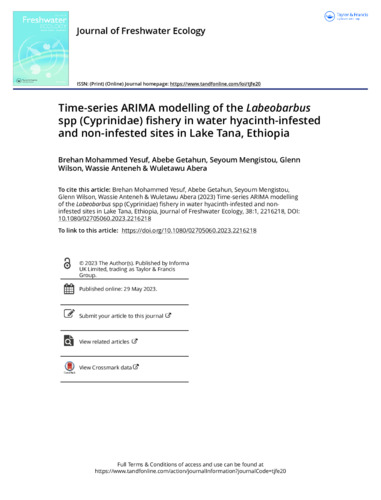Time-series ARIMA modelling of the Labeobarbus spp (Cyprinidae) fishery in water hyacinth-infested and non-infested sites in Lake Tana, Ethiopia
Ethiopia’s largest freshwater lake, Lake Tana, is home to 21 endemic fish species, the majority of which are cyprinids in the genus Labeobarbus. the lake is undergoing numerous ecological changes, including an invasion of water hyacinth (Eichhornia crassipes (Mart.) Solms (WH). the aim of this study was to predict the future fish productivity in lake tana by considering the increasing water hyacinth infestation. this was accomplished by analyzing a 12-year fishery-independent time-series data set of Labeobarbus, collected from sites infested and not infested by water hyacinth. the sta-tionarity of the data was investigated using the augmented Dickey-Fuller (aDF) unit root test. First-order data differencing was applied to solve the non-stationarity data to stationarity. With the same standardized fishing gillnet and the same sites, the cPUeduring the dry season decreased from 3,502 grams (3.5 kg/day) in 2010 to 360 grams (0.36 kg) in 2020 at the water hyacinth-infested sites, demonstrating a 90% decrease in the daily catch. a reduction in catch per unit effort (cPUe) is evident at the Wh sites in all seasons, and the rate of fall in there was faster than at the non-infested site. Box Jenkin’s auto-regressive integrated moving average models (aRiMa) modelling predicted that LabeobarbuscPUe will decline by a threefold % by 2032 compared to the current catch. Based on these results, the most suitable model for all the seasons and areas was confirmed to be aRiMa (0, 1, 0) using the lowest value of akaike information criteria (aic’s). the fish production declines with expanding Wh infestation will neces-sitate integrated water hyacinth reduction strategies, closed area and closed spawning seasons, and mesh size regulations to con-serve and utilize the resource sustainably. as Labeobarbus is the only examined species in this study, forecasts should be made for other commercially significant fish species in the lake, such as Oreochromis niloticus and Clarias gariepinus.

